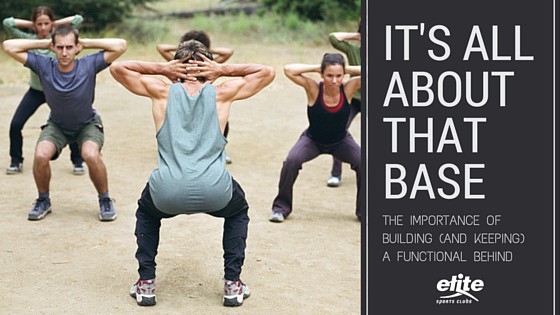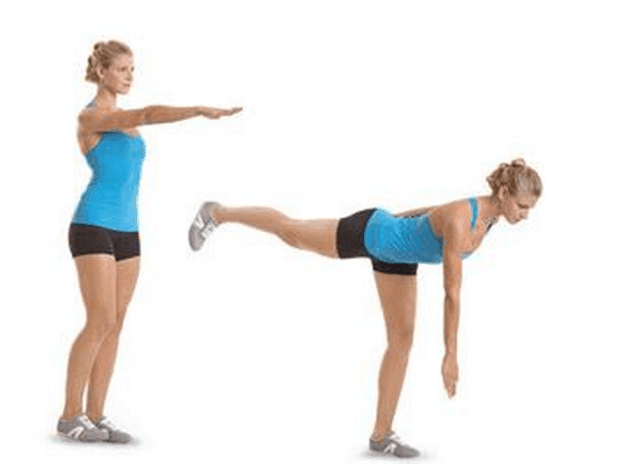
What?! Why would I need to be concerned about keeping my backside strong?
The glutes play a massive role in human movement. They are one of the largest muscle groups in the body, and are involved in golf swings, jumping, walking, running, throwing, striking and directional changes. In many ways, it’s the key to producing smooth, powerful movement.
Our lifestyles are “chair-driven,” and sitting for long periods of time deactivates the glutes, and de-conditions them. And many strength programs are not designed with glute activation in mind. Consequently, we end up with a non-functional posterior, which can contribute to low back pain, diminished sports performance, and a slew of other injuries.
The gluteal muscles (gluteus maximus, gluteus medius and gluteus minimus) stabilize the hip by counteracting gravity’s hip adduction torque. They assist with proper leg alignment by countering internal rotation and adduction forces, and also stabilize the pelvis and spine. Did you know that the largest and most powerful muscle in the body is the gluteus maximus? It’s the muscle that allows us to maintain our upright position, and walk on two feet (bipedalism).
Because our lifestyle of sitting contributes to putting these important muscles to sleep, many people, even athletes, lose their ability to activate them. Movement patterns of compensation become ingrained, and all sorts of injuries can result. So any strength program you follow should include glute activation. It should be a core inclusion of your conditioning, and if you are just starting out, be sure to get some advice from a fitness pro to help you be sure you are properly activating and strengthening your base.
Your glutes may be inhibited and will not fire properly when they are supposed to, especially if this information is new to you, or you are just beginning an exercise program. Compensation by other muscles may make it difficult to target the glutes specifically, especially when using bilateral exercises like squats. Instead, look to exercises that require single-leg balance, stability of the pelvis, and hip extension.
Single leg squat: With one leg extended in front, draw your bellybutton in toward your spine, tightening your core. Slowly sit back and down, keeping your working leg knee behind your toes, then stand back up. Start with 12 per side, working your way up to 3 sets of 12 per side.
Single leg balance: Again, begin by activating your core by drawing your center line in toward your spine. Stand tall, with your shoulders back, and lift one leg. Hold it for as long as you can, up to 30 seconds, and then change to the other side. Start with 5 per side, working your way up to 10.
Single leg hip extension: Honestly, I call this one The Bobbing Bird, in reference to those cute little red tabletop birds filled with fluid from the 70’s. If you remember those, you’ll immediately get this exercise! Tighten your core, reach your hand out in front of you, and “bob” forward, reaching toward the floor. Keep your hips level, and the supporting leg slightly bent. Return to standing. Perform 12 per side, working your way up to 3 sets of 12 as you improve. If you need/want a focus point, add that in front of you in the form of a dumbbell or other object, and “bob” toward it.

Single leg hip abduction: Resting your head on a block or towel—aligned in the spine, and the body is one long level line—lift the top leg up, and bring it down, almost all the way, but not quite. Repeat this 12 times per side, working your way up to 3 sets of 12 repetitions. Keep the toes ever so slightly pointed down toward the floor. This helps to activate the gluteus medius, and the gluteus maximus. Keep the leg extended and engaged.
Get your own personalized plan!
Written by Melissa Abramovich, ACE CPT, NASM CGT, AAHFRP Medical Exercise Specialist at Elite Sports Club-River Glen
Melissa Abramovich went into Personal Training and Group Exercise instruction after successfully losing 140 pounds through healthy diet and exercise. Her desire to help others drove her forward into a career helping others to make healthier choices. She is an ACE certified personal trainer and now also a Medical Exercise Specialist (AAHFRP), helping clients with a myriad of health issues at Elite Sports Clubs. She holds a Bachelor’s degree, and many group exercise related certifications as well.


